Business Law Report: Analysis of English Legal System & Obligations
VerifiedAdded on 2020/09/17
|15
|3559
|34
Report
AI Summary
This business law report provides a comprehensive overview of the English legal system, including its sources, structural functioning, and the significant role of the government in law-making. It delves into the various legal obligations of employers in a business environment, examining the impact of legislation on corporate organizations. The report also explores legal solutions to business problems, justifying recommended solutions, and analyzing alternate dispute resolution (ADR) processes and their benefits. It concludes with recommendations for alternate legal solutions for corporate problems, offering a thorough analysis of key aspects of business law within the UK context.
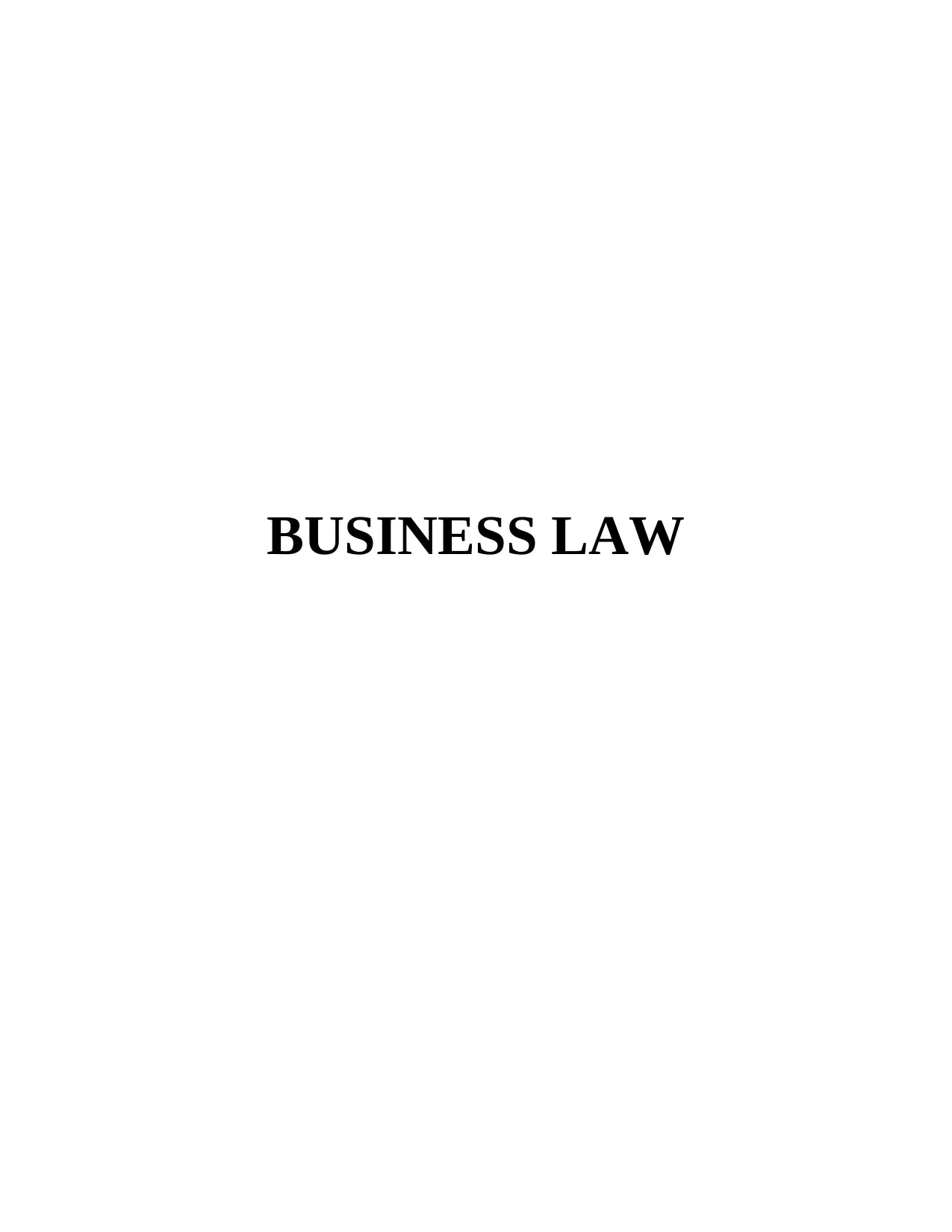
BUSINESS LAW
Paraphrase This Document
Need a fresh take? Get an instant paraphrase of this document with our AI Paraphraser
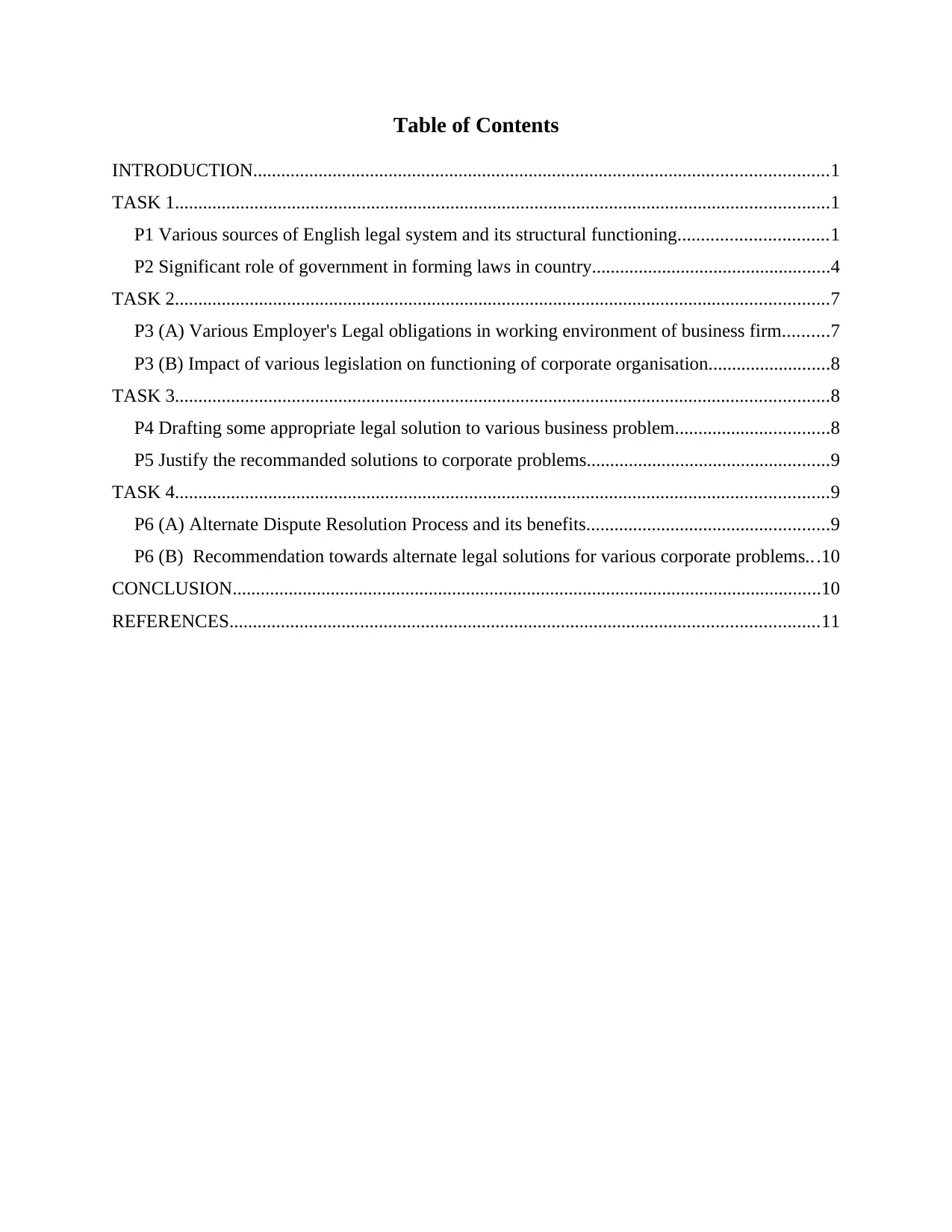
Table of Contents
INTRODUCTION...........................................................................................................................1
TASK 1............................................................................................................................................1
P1 Various sources of English legal system and its structural functioning................................1
P2 Significant role of government in forming laws in country...................................................4
TASK 2............................................................................................................................................7
P3 (A) Various Employer's Legal obligations in working environment of business firm..........7
P3 (B) Impact of various legislation on functioning of corporate organisation..........................8
TASK 3............................................................................................................................................8
P4 Drafting some appropriate legal solution to various business problem.................................8
P5 Justify the recommanded solutions to corporate problems....................................................9
TASK 4............................................................................................................................................9
P6 (A) Alternate Dispute Resolution Process and its benefits....................................................9
P6 (B) Recommendation towards alternate legal solutions for various corporate problems.. .10
CONCLUSION..............................................................................................................................10
REFERENCES..............................................................................................................................11
INTRODUCTION...........................................................................................................................1
TASK 1............................................................................................................................................1
P1 Various sources of English legal system and its structural functioning................................1
P2 Significant role of government in forming laws in country...................................................4
TASK 2............................................................................................................................................7
P3 (A) Various Employer's Legal obligations in working environment of business firm..........7
P3 (B) Impact of various legislation on functioning of corporate organisation..........................8
TASK 3............................................................................................................................................8
P4 Drafting some appropriate legal solution to various business problem.................................8
P5 Justify the recommanded solutions to corporate problems....................................................9
TASK 4............................................................................................................................................9
P6 (A) Alternate Dispute Resolution Process and its benefits....................................................9
P6 (B) Recommendation towards alternate legal solutions for various corporate problems.. .10
CONCLUSION..............................................................................................................................10
REFERENCES..............................................................................................................................11

⊘ This is a preview!⊘
Do you want full access?
Subscribe today to unlock all pages.

Trusted by 1+ million students worldwide
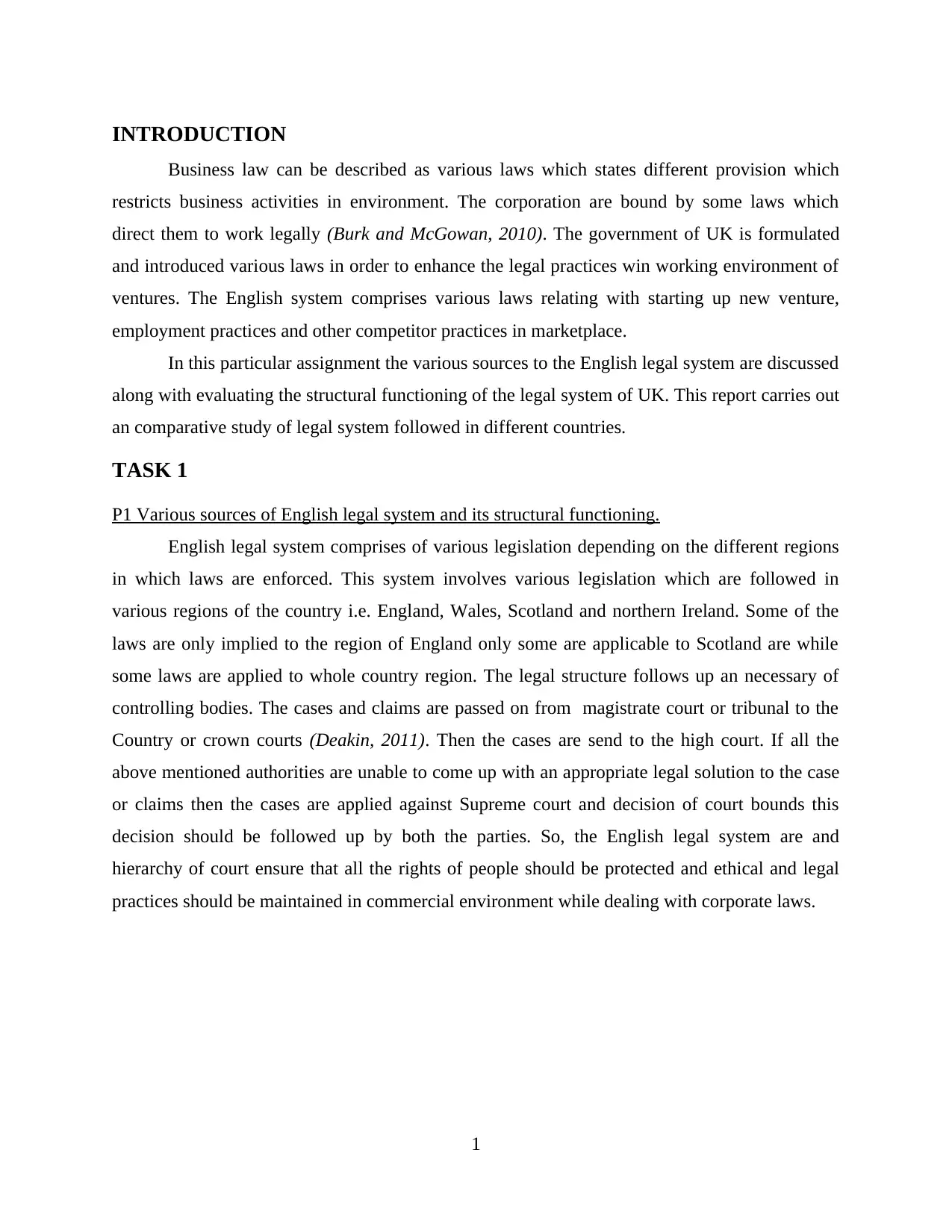
INTRODUCTION
Business law can be described as various laws which states different provision which
restricts business activities in environment. The corporation are bound by some laws which
direct them to work legally (Burk and McGowan, 2010). The government of UK is formulated
and introduced various laws in order to enhance the legal practices win working environment of
ventures. The English system comprises various laws relating with starting up new venture,
employment practices and other competitor practices in marketplace.
In this particular assignment the various sources to the English legal system are discussed
along with evaluating the structural functioning of the legal system of UK. This report carries out
an comparative study of legal system followed in different countries.
TASK 1
P1 Various sources of English legal system and its structural functioning.
English legal system comprises of various legislation depending on the different regions
in which laws are enforced. This system involves various legislation which are followed in
various regions of the country i.e. England, Wales, Scotland and northern Ireland. Some of the
laws are only implied to the region of England only some are applicable to Scotland are while
some laws are applied to whole country region. The legal structure follows up an necessary of
controlling bodies. The cases and claims are passed on from magistrate court or tribunal to the
Country or crown courts (Deakin, 2011). Then the cases are send to the high court. If all the
above mentioned authorities are unable to come up with an appropriate legal solution to the case
or claims then the cases are applied against Supreme court and decision of court bounds this
decision should be followed up by both the parties. So, the English legal system are and
hierarchy of court ensure that all the rights of people should be protected and ethical and legal
practices should be maintained in commercial environment while dealing with corporate laws.
1
Business law can be described as various laws which states different provision which
restricts business activities in environment. The corporation are bound by some laws which
direct them to work legally (Burk and McGowan, 2010). The government of UK is formulated
and introduced various laws in order to enhance the legal practices win working environment of
ventures. The English system comprises various laws relating with starting up new venture,
employment practices and other competitor practices in marketplace.
In this particular assignment the various sources to the English legal system are discussed
along with evaluating the structural functioning of the legal system of UK. This report carries out
an comparative study of legal system followed in different countries.
TASK 1
P1 Various sources of English legal system and its structural functioning.
English legal system comprises of various legislation depending on the different regions
in which laws are enforced. This system involves various legislation which are followed in
various regions of the country i.e. England, Wales, Scotland and northern Ireland. Some of the
laws are only implied to the region of England only some are applicable to Scotland are while
some laws are applied to whole country region. The legal structure follows up an necessary of
controlling bodies. The cases and claims are passed on from magistrate court or tribunal to the
Country or crown courts (Deakin, 2011). Then the cases are send to the high court. If all the
above mentioned authorities are unable to come up with an appropriate legal solution to the case
or claims then the cases are applied against Supreme court and decision of court bounds this
decision should be followed up by both the parties. So, the English legal system are and
hierarchy of court ensure that all the rights of people should be protected and ethical and legal
practices should be maintained in commercial environment while dealing with corporate laws.
1
Paraphrase This Document
Need a fresh take? Get an instant paraphrase of this document with our AI Paraphraser
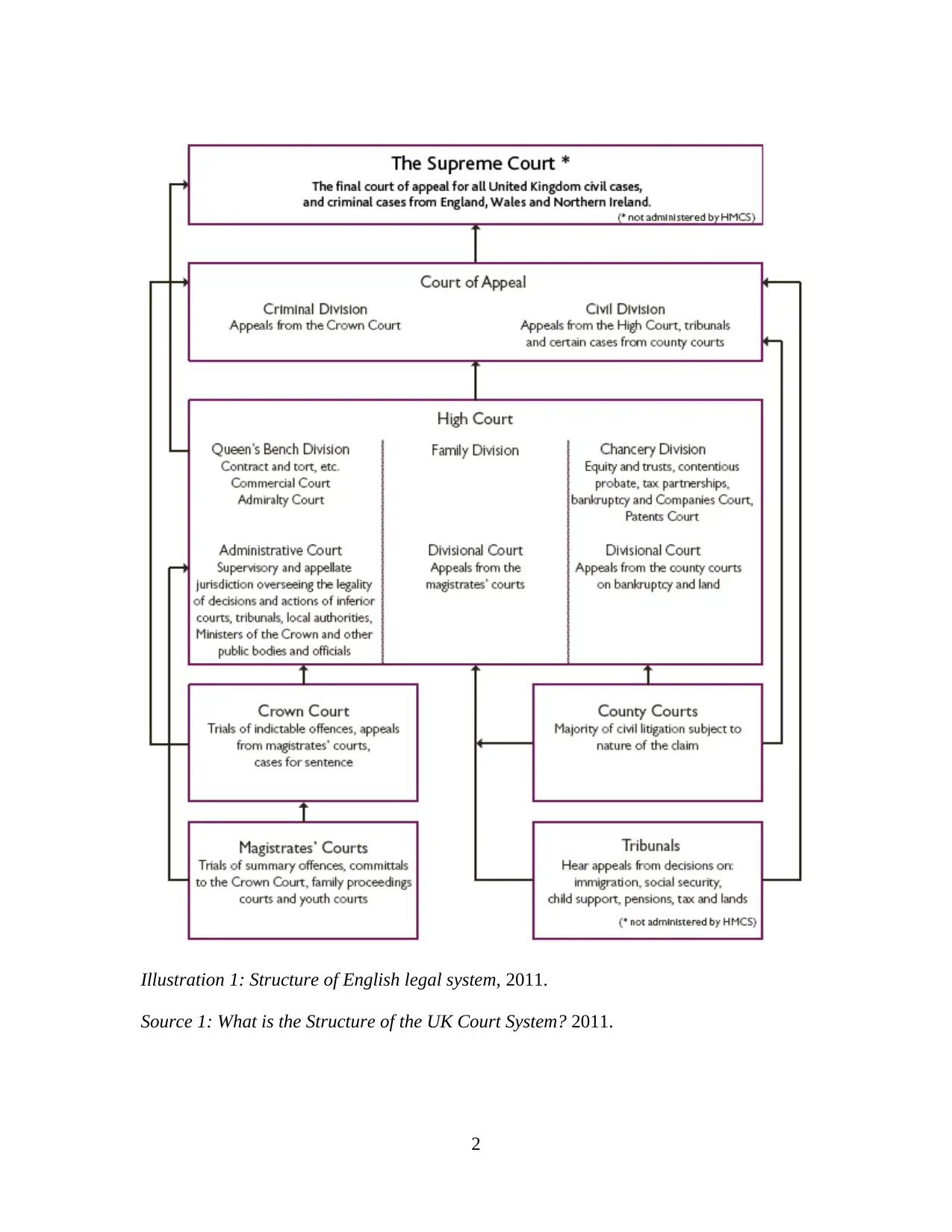
2
Illustration 1: Structure of English legal system, 2011.
Source 1: What is the Structure of the UK Court System? 2011.
Illustration 1: Structure of English legal system, 2011.
Source 1: What is the Structure of the UK Court System? 2011.
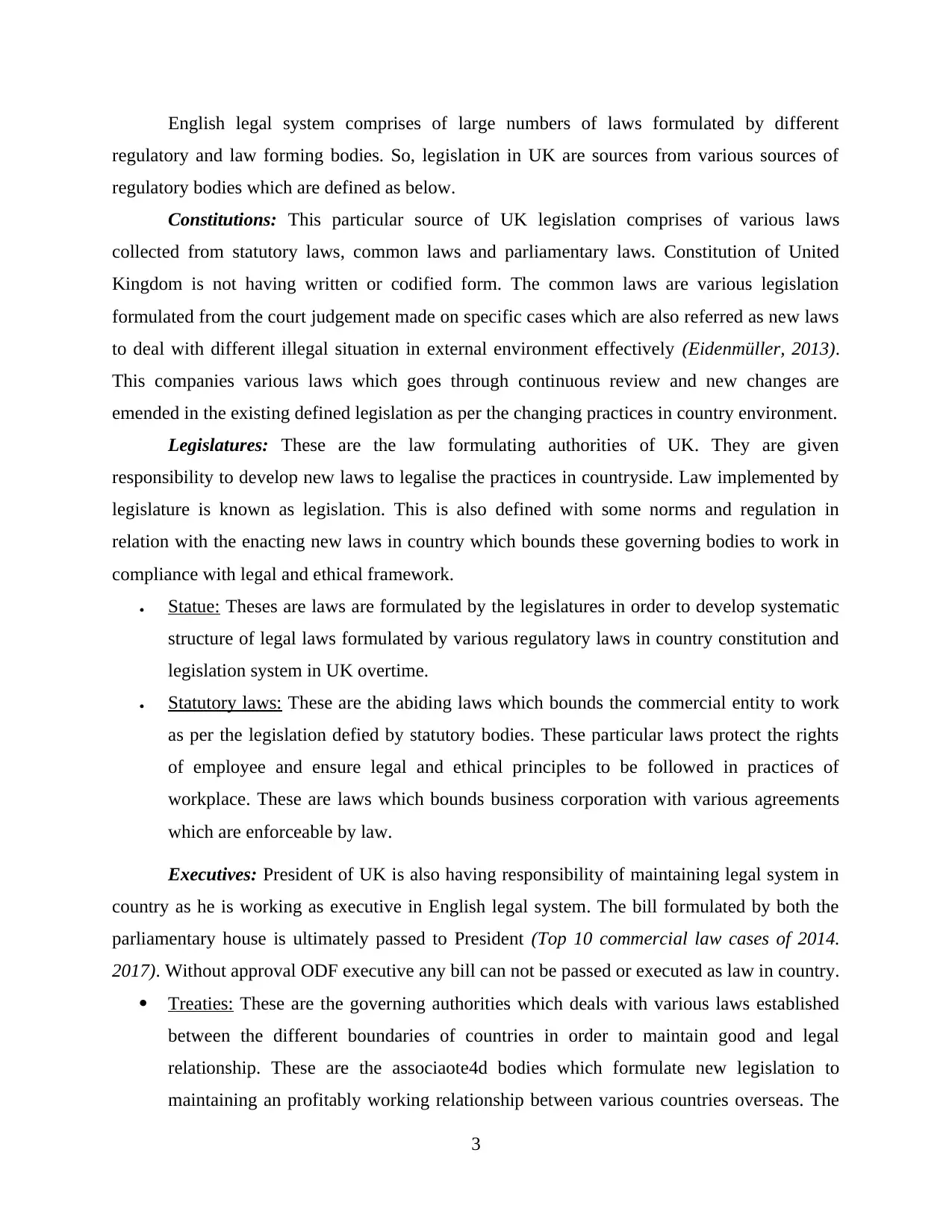
English legal system comprises of large numbers of laws formulated by different
regulatory and law forming bodies. So, legislation in UK are sources from various sources of
regulatory bodies which are defined as below.
Constitutions: This particular source of UK legislation comprises of various laws
collected from statutory laws, common laws and parliamentary laws. Constitution of United
Kingdom is not having written or codified form. The common laws are various legislation
formulated from the court judgement made on specific cases which are also referred as new laws
to deal with different illegal situation in external environment effectively (Eidenmüller, 2013).
This companies various laws which goes through continuous review and new changes are
emended in the existing defined legislation as per the changing practices in country environment.
Legislatures: These are the law formulating authorities of UK. They are given
responsibility to develop new laws to legalise the practices in countryside. Law implemented by
legislature is known as legislation. This is also defined with some norms and regulation in
relation with the enacting new laws in country which bounds these governing bodies to work in
compliance with legal and ethical framework.
Statue: Theses are laws are formulated by the legislatures in order to develop systematic
structure of legal laws formulated by various regulatory laws in country constitution and
legislation system in UK overtime.
Statutory laws: These are the abiding laws which bounds the commercial entity to work
as per the legislation defied by statutory bodies. These particular laws protect the rights
of employee and ensure legal and ethical principles to be followed in practices of
workplace. These are laws which bounds business corporation with various agreements
which are enforceable by law.
Executives: President of UK is also having responsibility of maintaining legal system in
country as he is working as executive in English legal system. The bill formulated by both the
parliamentary house is ultimately passed to President (Top 10 commercial law cases of 2014.
2017). Without approval ODF executive any bill can not be passed or executed as law in country.
Treaties: These are the governing authorities which deals with various laws established
between the different boundaries of countries in order to maintain good and legal
relationship. These are the associaote4d bodies which formulate new legislation to
maintaining an profitably working relationship between various countries overseas. The
3
regulatory and law forming bodies. So, legislation in UK are sources from various sources of
regulatory bodies which are defined as below.
Constitutions: This particular source of UK legislation comprises of various laws
collected from statutory laws, common laws and parliamentary laws. Constitution of United
Kingdom is not having written or codified form. The common laws are various legislation
formulated from the court judgement made on specific cases which are also referred as new laws
to deal with different illegal situation in external environment effectively (Eidenmüller, 2013).
This companies various laws which goes through continuous review and new changes are
emended in the existing defined legislation as per the changing practices in country environment.
Legislatures: These are the law formulating authorities of UK. They are given
responsibility to develop new laws to legalise the practices in countryside. Law implemented by
legislature is known as legislation. This is also defined with some norms and regulation in
relation with the enacting new laws in country which bounds these governing bodies to work in
compliance with legal and ethical framework.
Statue: Theses are laws are formulated by the legislatures in order to develop systematic
structure of legal laws formulated by various regulatory laws in country constitution and
legislation system in UK overtime.
Statutory laws: These are the abiding laws which bounds the commercial entity to work
as per the legislation defied by statutory bodies. These particular laws protect the rights
of employee and ensure legal and ethical principles to be followed in practices of
workplace. These are laws which bounds business corporation with various agreements
which are enforceable by law.
Executives: President of UK is also having responsibility of maintaining legal system in
country as he is working as executive in English legal system. The bill formulated by both the
parliamentary house is ultimately passed to President (Top 10 commercial law cases of 2014.
2017). Without approval ODF executive any bill can not be passed or executed as law in country.
Treaties: These are the governing authorities which deals with various laws established
between the different boundaries of countries in order to maintain good and legal
relationship. These are the associaote4d bodies which formulate new legislation to
maintaining an profitably working relationship between various countries overseas. The
3
⊘ This is a preview!⊘
Do you want full access?
Subscribe today to unlock all pages.

Trusted by 1+ million students worldwide
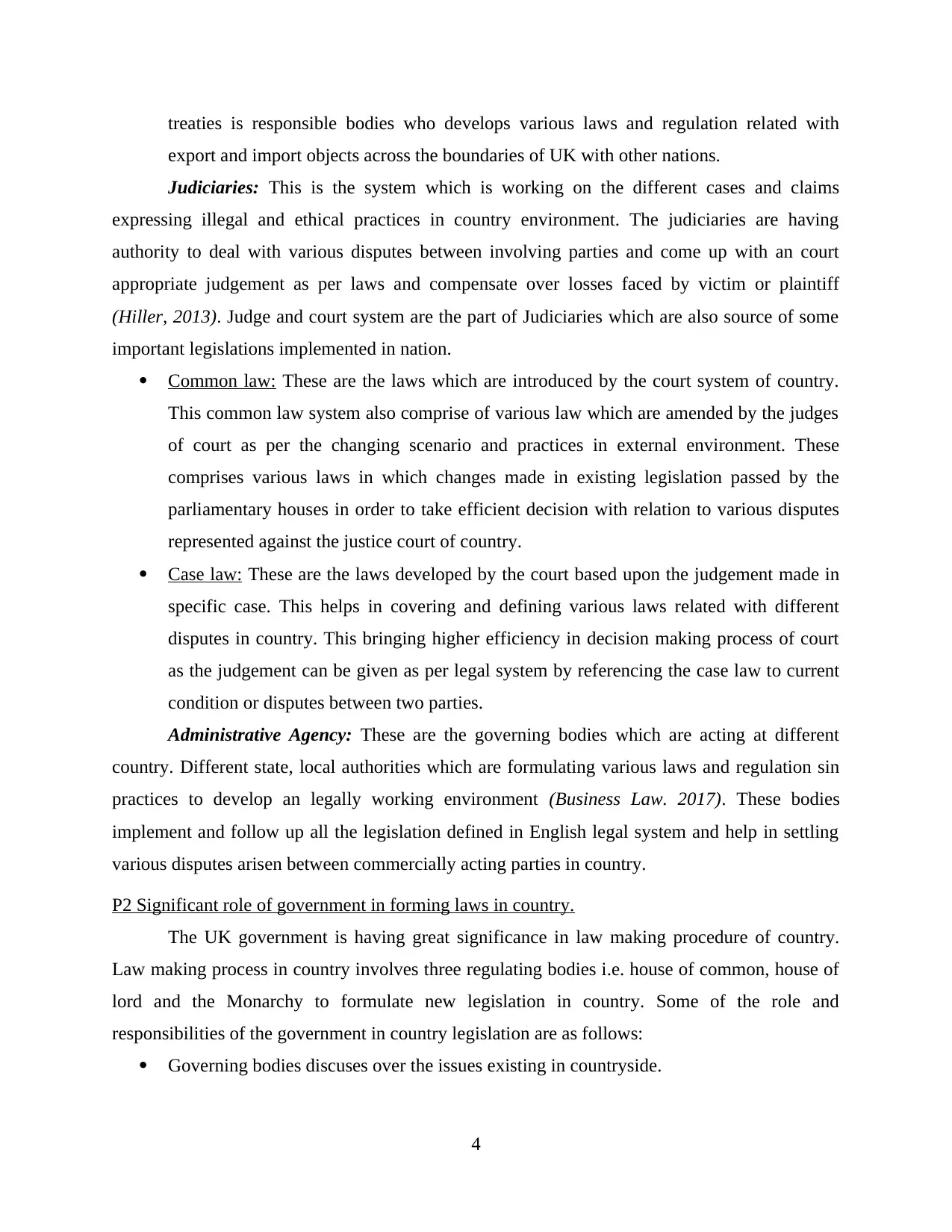
treaties is responsible bodies who develops various laws and regulation related with
export and import objects across the boundaries of UK with other nations.
Judiciaries: This is the system which is working on the different cases and claims
expressing illegal and ethical practices in country environment. The judiciaries are having
authority to deal with various disputes between involving parties and come up with an court
appropriate judgement as per laws and compensate over losses faced by victim or plaintiff
(Hiller, 2013). Judge and court system are the part of Judiciaries which are also source of some
important legislations implemented in nation.
Common law: These are the laws which are introduced by the court system of country.
This common law system also comprise of various law which are amended by the judges
of court as per the changing scenario and practices in external environment. These
comprises various laws in which changes made in existing legislation passed by the
parliamentary houses in order to take efficient decision with relation to various disputes
represented against the justice court of country.
Case law: These are the laws developed by the court based upon the judgement made in
specific case. This helps in covering and defining various laws related with different
disputes in country. This bringing higher efficiency in decision making process of court
as the judgement can be given as per legal system by referencing the case law to current
condition or disputes between two parties.
Administrative Agency: These are the governing bodies which are acting at different
country. Different state, local authorities which are formulating various laws and regulation sin
practices to develop an legally working environment (Business Law. 2017). These bodies
implement and follow up all the legislation defined in English legal system and help in settling
various disputes arisen between commercially acting parties in country.
P2 Significant role of government in forming laws in country.
The UK government is having great significance in law making procedure of country.
Law making process in country involves three regulating bodies i.e. house of common, house of
lord and the Monarchy to formulate new legislation in country. Some of the role and
responsibilities of the government in country legislation are as follows:
Governing bodies discuses over the issues existing in countryside.
4
export and import objects across the boundaries of UK with other nations.
Judiciaries: This is the system which is working on the different cases and claims
expressing illegal and ethical practices in country environment. The judiciaries are having
authority to deal with various disputes between involving parties and come up with an court
appropriate judgement as per laws and compensate over losses faced by victim or plaintiff
(Hiller, 2013). Judge and court system are the part of Judiciaries which are also source of some
important legislations implemented in nation.
Common law: These are the laws which are introduced by the court system of country.
This common law system also comprise of various law which are amended by the judges
of court as per the changing scenario and practices in external environment. These
comprises various laws in which changes made in existing legislation passed by the
parliamentary houses in order to take efficient decision with relation to various disputes
represented against the justice court of country.
Case law: These are the laws developed by the court based upon the judgement made in
specific case. This helps in covering and defining various laws related with different
disputes in country. This bringing higher efficiency in decision making process of court
as the judgement can be given as per legal system by referencing the case law to current
condition or disputes between two parties.
Administrative Agency: These are the governing bodies which are acting at different
country. Different state, local authorities which are formulating various laws and regulation sin
practices to develop an legally working environment (Business Law. 2017). These bodies
implement and follow up all the legislation defined in English legal system and help in settling
various disputes arisen between commercially acting parties in country.
P2 Significant role of government in forming laws in country.
The UK government is having great significance in law making procedure of country.
Law making process in country involves three regulating bodies i.e. house of common, house of
lord and the Monarchy to formulate new legislation in country. Some of the role and
responsibilities of the government in country legislation are as follows:
Governing bodies discuses over the issues existing in countryside.
4
Paraphrase This Document
Need a fresh take? Get an instant paraphrase of this document with our AI Paraphraser
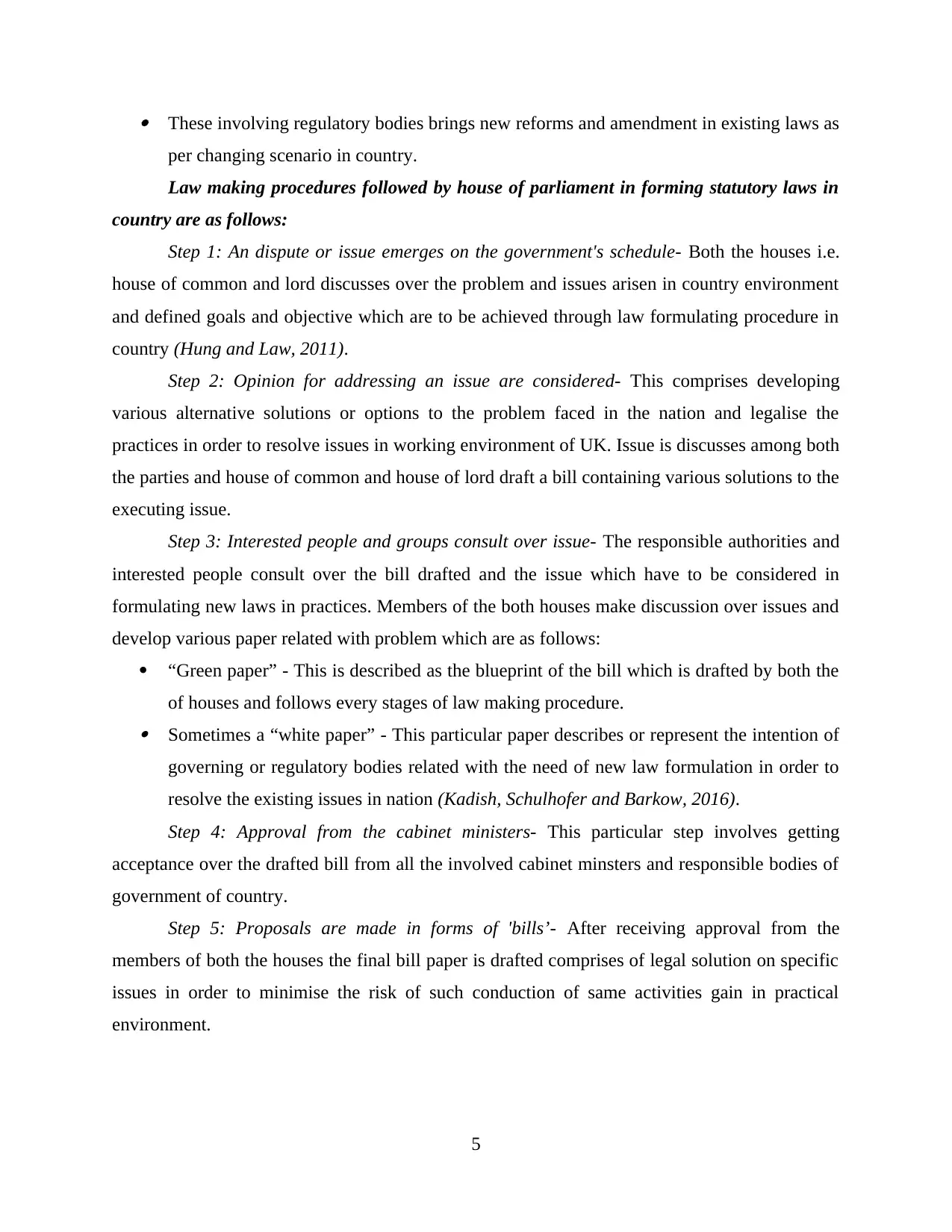
These involving regulatory bodies brings new reforms and amendment in existing laws as
per changing scenario in country.
Law making procedures followed by house of parliament in forming statutory laws in
country are as follows:
Step 1: An dispute or issue emerges on the government's schedule- Both the houses i.e.
house of common and lord discusses over the problem and issues arisen in country environment
and defined goals and objective which are to be achieved through law formulating procedure in
country (Hung and Law, 2011).
Step 2: Opinion for addressing an issue are considered- This comprises developing
various alternative solutions or options to the problem faced in the nation and legalise the
practices in order to resolve issues in working environment of UK. Issue is discusses among both
the parties and house of common and house of lord draft a bill containing various solutions to the
executing issue.
Step 3: Interested people and groups consult over issue- The responsible authorities and
interested people consult over the bill drafted and the issue which have to be considered in
formulating new laws in practices. Members of the both houses make discussion over issues and
develop various paper related with problem which are as follows:
“Green paper” - This is described as the blueprint of the bill which is drafted by both the
of houses and follows every stages of law making procedure. Sometimes a “white paper” - This particular paper describes or represent the intention of
governing or regulatory bodies related with the need of new law formulation in order to
resolve the existing issues in nation (Kadish, Schulhofer and Barkow, 2016).
Step 4: Approval from the cabinet ministers- This particular step involves getting
acceptance over the drafted bill from all the involved cabinet minsters and responsible bodies of
government of country.
Step 5: Proposals are made in forms of 'bills’- After receiving approval from the
members of both the houses the final bill paper is drafted comprises of legal solution on specific
issues in order to minimise the risk of such conduction of same activities gain in practical
environment.
5
per changing scenario in country.
Law making procedures followed by house of parliament in forming statutory laws in
country are as follows:
Step 1: An dispute or issue emerges on the government's schedule- Both the houses i.e.
house of common and lord discusses over the problem and issues arisen in country environment
and defined goals and objective which are to be achieved through law formulating procedure in
country (Hung and Law, 2011).
Step 2: Opinion for addressing an issue are considered- This comprises developing
various alternative solutions or options to the problem faced in the nation and legalise the
practices in order to resolve issues in working environment of UK. Issue is discusses among both
the parties and house of common and house of lord draft a bill containing various solutions to the
executing issue.
Step 3: Interested people and groups consult over issue- The responsible authorities and
interested people consult over the bill drafted and the issue which have to be considered in
formulating new laws in practices. Members of the both houses make discussion over issues and
develop various paper related with problem which are as follows:
“Green paper” - This is described as the blueprint of the bill which is drafted by both the
of houses and follows every stages of law making procedure. Sometimes a “white paper” - This particular paper describes or represent the intention of
governing or regulatory bodies related with the need of new law formulation in order to
resolve the existing issues in nation (Kadish, Schulhofer and Barkow, 2016).
Step 4: Approval from the cabinet ministers- This particular step involves getting
acceptance over the drafted bill from all the involved cabinet minsters and responsible bodies of
government of country.
Step 5: Proposals are made in forms of 'bills’- After receiving approval from the
members of both the houses the final bill paper is drafted comprises of legal solution on specific
issues in order to minimise the risk of such conduction of same activities gain in practical
environment.
5
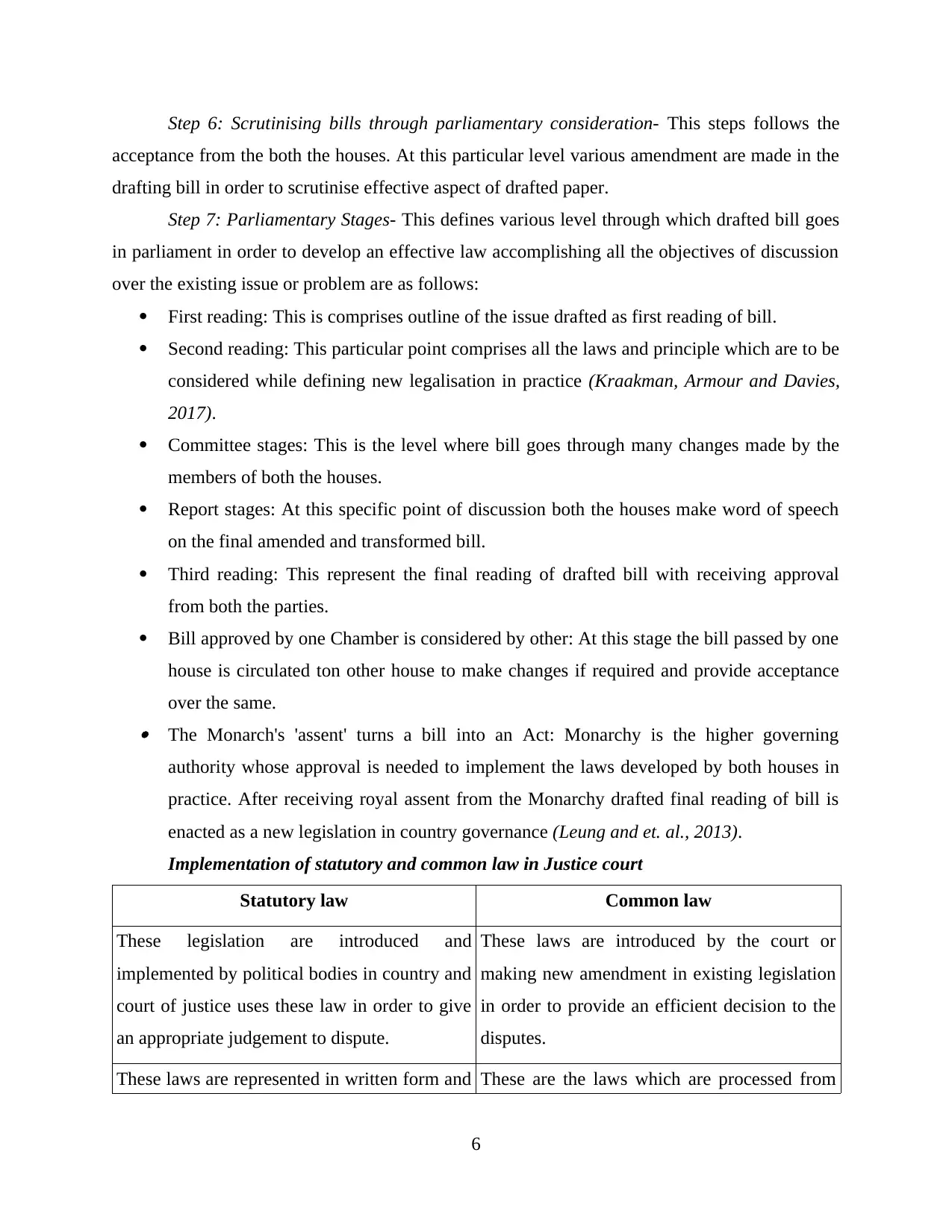
Step 6: Scrutinising bills through parliamentary consideration- This steps follows the
acceptance from the both the houses. At this particular level various amendment are made in the
drafting bill in order to scrutinise effective aspect of drafted paper.
Step 7: Parliamentary Stages- This defines various level through which drafted bill goes
in parliament in order to develop an effective law accomplishing all the objectives of discussion
over the existing issue or problem are as follows:
First reading: This is comprises outline of the issue drafted as first reading of bill.
Second reading: This particular point comprises all the laws and principle which are to be
considered while defining new legalisation in practice (Kraakman, Armour and Davies,
2017).
Committee stages: This is the level where bill goes through many changes made by the
members of both the houses.
Report stages: At this specific point of discussion both the houses make word of speech
on the final amended and transformed bill.
Third reading: This represent the final reading of drafted bill with receiving approval
from both the parties.
Bill approved by one Chamber is considered by other: At this stage the bill passed by one
house is circulated ton other house to make changes if required and provide acceptance
over the same. The Monarch's 'assent' turns a bill into an Act: Monarchy is the higher governing
authority whose approval is needed to implement the laws developed by both houses in
practice. After receiving royal assent from the Monarchy drafted final reading of bill is
enacted as a new legislation in country governance (Leung and et. al., 2013).
Implementation of statutory and common law in Justice court
Statutory law Common law
These legislation are introduced and
implemented by political bodies in country and
court of justice uses these law in order to give
an appropriate judgement to dispute.
These laws are introduced by the court or
making new amendment in existing legislation
in order to provide an efficient decision to the
disputes.
These laws are represented in written form and These are the laws which are processed from
6
acceptance from the both the houses. At this particular level various amendment are made in the
drafting bill in order to scrutinise effective aspect of drafted paper.
Step 7: Parliamentary Stages- This defines various level through which drafted bill goes
in parliament in order to develop an effective law accomplishing all the objectives of discussion
over the existing issue or problem are as follows:
First reading: This is comprises outline of the issue drafted as first reading of bill.
Second reading: This particular point comprises all the laws and principle which are to be
considered while defining new legalisation in practice (Kraakman, Armour and Davies,
2017).
Committee stages: This is the level where bill goes through many changes made by the
members of both the houses.
Report stages: At this specific point of discussion both the houses make word of speech
on the final amended and transformed bill.
Third reading: This represent the final reading of drafted bill with receiving approval
from both the parties.
Bill approved by one Chamber is considered by other: At this stage the bill passed by one
house is circulated ton other house to make changes if required and provide acceptance
over the same. The Monarch's 'assent' turns a bill into an Act: Monarchy is the higher governing
authority whose approval is needed to implement the laws developed by both houses in
practice. After receiving royal assent from the Monarchy drafted final reading of bill is
enacted as a new legislation in country governance (Leung and et. al., 2013).
Implementation of statutory and common law in Justice court
Statutory law Common law
These legislation are introduced and
implemented by political bodies in country and
court of justice uses these law in order to give
an appropriate judgement to dispute.
These laws are introduced by the court or
making new amendment in existing legislation
in order to provide an efficient decision to the
disputes.
These laws are represented in written form and These are the laws which are processed from
6
⊘ This is a preview!⊘
Do you want full access?
Subscribe today to unlock all pages.

Trusted by 1+ million students worldwide
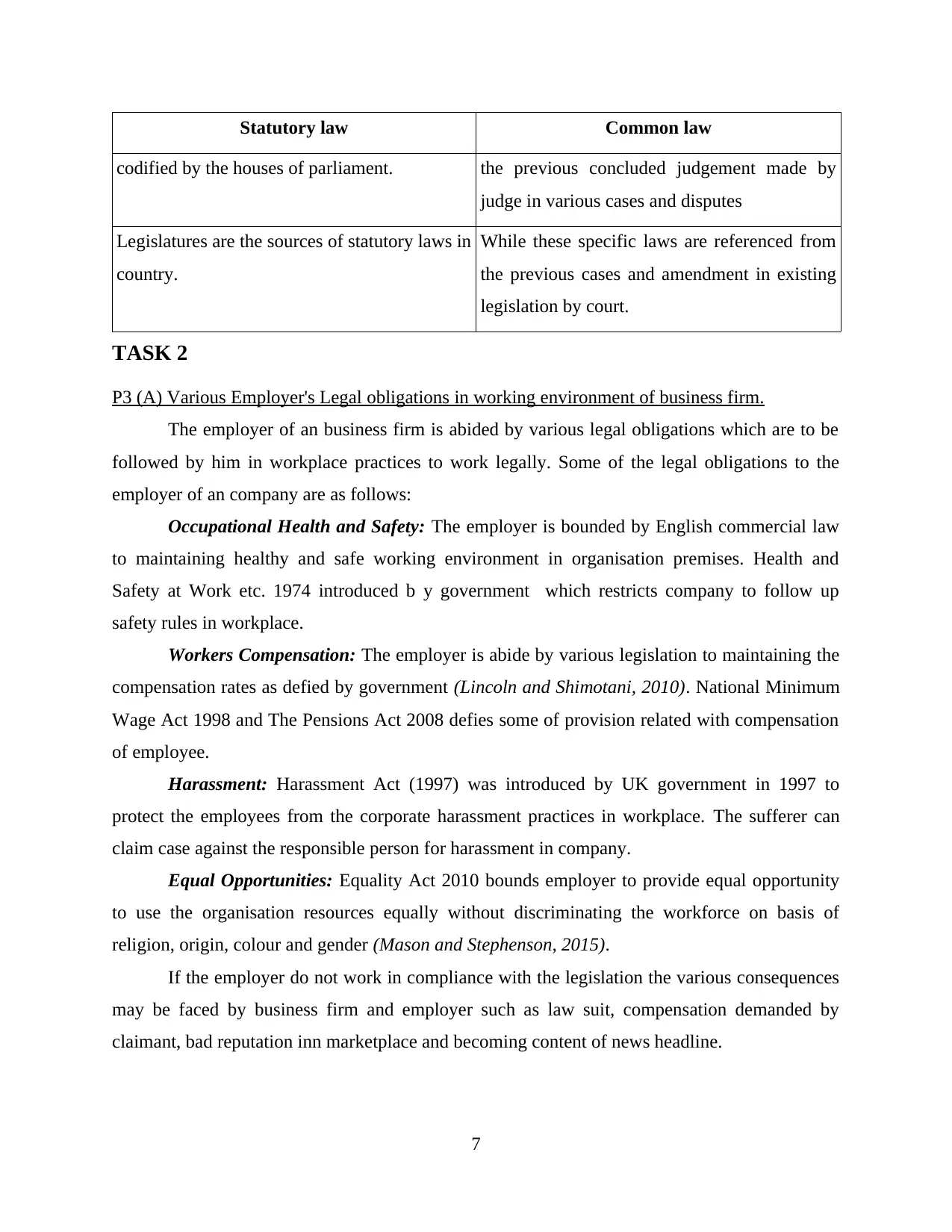
Statutory law Common law
codified by the houses of parliament. the previous concluded judgement made by
judge in various cases and disputes
Legislatures are the sources of statutory laws in
country.
While these specific laws are referenced from
the previous cases and amendment in existing
legislation by court.
TASK 2
P3 (A) Various Employer's Legal obligations in working environment of business firm.
The employer of an business firm is abided by various legal obligations which are to be
followed by him in workplace practices to work legally. Some of the legal obligations to the
employer of an company are as follows:
Occupational Health and Safety: The employer is bounded by English commercial law
to maintaining healthy and safe working environment in organisation premises. Health and
Safety at Work etc. 1974 introduced b y government which restricts company to follow up
safety rules in workplace.
Workers Compensation: The employer is abide by various legislation to maintaining the
compensation rates as defied by government (Lincoln and Shimotani, 2010). National Minimum
Wage Act 1998 and The Pensions Act 2008 defies some of provision related with compensation
of employee.
Harassment: Harassment Act (1997) was introduced by UK government in 1997 to
protect the employees from the corporate harassment practices in workplace. The sufferer can
claim case against the responsible person for harassment in company.
Equal Opportunities: Equality Act 2010 bounds employer to provide equal opportunity
to use the organisation resources equally without discriminating the workforce on basis of
religion, origin, colour and gender (Mason and Stephenson, 2015).
If the employer do not work in compliance with the legislation the various consequences
may be faced by business firm and employer such as law suit, compensation demanded by
claimant, bad reputation inn marketplace and becoming content of news headline.
7
codified by the houses of parliament. the previous concluded judgement made by
judge in various cases and disputes
Legislatures are the sources of statutory laws in
country.
While these specific laws are referenced from
the previous cases and amendment in existing
legislation by court.
TASK 2
P3 (A) Various Employer's Legal obligations in working environment of business firm.
The employer of an business firm is abided by various legal obligations which are to be
followed by him in workplace practices to work legally. Some of the legal obligations to the
employer of an company are as follows:
Occupational Health and Safety: The employer is bounded by English commercial law
to maintaining healthy and safe working environment in organisation premises. Health and
Safety at Work etc. 1974 introduced b y government which restricts company to follow up
safety rules in workplace.
Workers Compensation: The employer is abide by various legislation to maintaining the
compensation rates as defied by government (Lincoln and Shimotani, 2010). National Minimum
Wage Act 1998 and The Pensions Act 2008 defies some of provision related with compensation
of employee.
Harassment: Harassment Act (1997) was introduced by UK government in 1997 to
protect the employees from the corporate harassment practices in workplace. The sufferer can
claim case against the responsible person for harassment in company.
Equal Opportunities: Equality Act 2010 bounds employer to provide equal opportunity
to use the organisation resources equally without discriminating the workforce on basis of
religion, origin, colour and gender (Mason and Stephenson, 2015).
If the employer do not work in compliance with the legislation the various consequences
may be faced by business firm and employer such as law suit, compensation demanded by
claimant, bad reputation inn marketplace and becoming content of news headline.
7
Paraphrase This Document
Need a fresh take? Get an instant paraphrase of this document with our AI Paraphraser
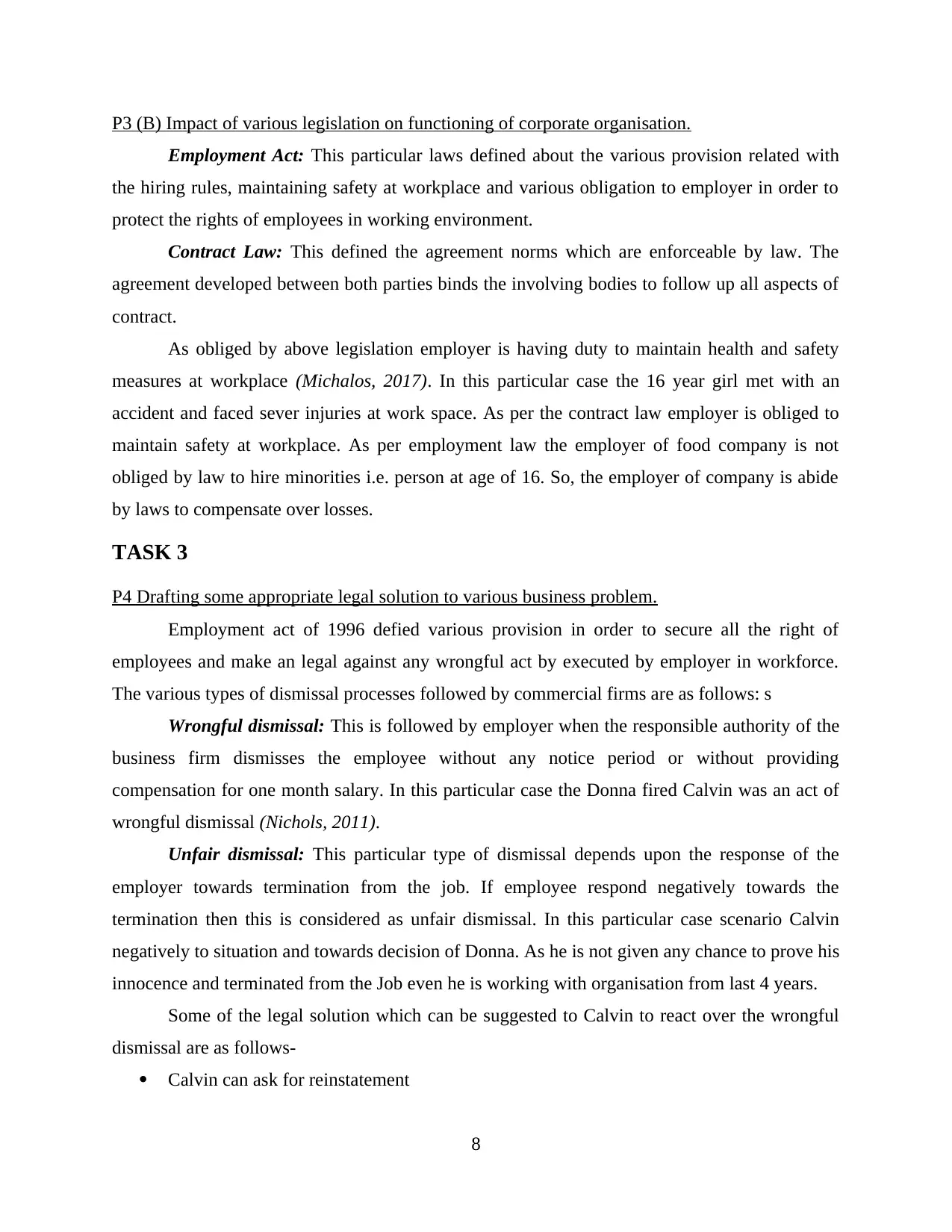
P3 (B) Impact of various legislation on functioning of corporate organisation.
Employment Act: This particular laws defined about the various provision related with
the hiring rules, maintaining safety at workplace and various obligation to employer in order to
protect the rights of employees in working environment.
Contract Law: This defined the agreement norms which are enforceable by law. The
agreement developed between both parties binds the involving bodies to follow up all aspects of
contract.
As obliged by above legislation employer is having duty to maintain health and safety
measures at workplace (Michalos, 2017). In this particular case the 16 year girl met with an
accident and faced sever injuries at work space. As per the contract law employer is obliged to
maintain safety at workplace. As per employment law the employer of food company is not
obliged by law to hire minorities i.e. person at age of 16. So, the employer of company is abide
by laws to compensate over losses.
TASK 3
P4 Drafting some appropriate legal solution to various business problem.
Employment act of 1996 defied various provision in order to secure all the right of
employees and make an legal against any wrongful act by executed by employer in workforce.
The various types of dismissal processes followed by commercial firms are as follows: s
Wrongful dismissal: This is followed by employer when the responsible authority of the
business firm dismisses the employee without any notice period or without providing
compensation for one month salary. In this particular case the Donna fired Calvin was an act of
wrongful dismissal (Nichols, 2011).
Unfair dismissal: This particular type of dismissal depends upon the response of the
employer towards termination from the job. If employee respond negatively towards the
termination then this is considered as unfair dismissal. In this particular case scenario Calvin
negatively to situation and towards decision of Donna. As he is not given any chance to prove his
innocence and terminated from the Job even he is working with organisation from last 4 years.
Some of the legal solution which can be suggested to Calvin to react over the wrongful
dismissal are as follows-
Calvin can ask for reinstatement
8
Employment Act: This particular laws defined about the various provision related with
the hiring rules, maintaining safety at workplace and various obligation to employer in order to
protect the rights of employees in working environment.
Contract Law: This defined the agreement norms which are enforceable by law. The
agreement developed between both parties binds the involving bodies to follow up all aspects of
contract.
As obliged by above legislation employer is having duty to maintain health and safety
measures at workplace (Michalos, 2017). In this particular case the 16 year girl met with an
accident and faced sever injuries at work space. As per the contract law employer is obliged to
maintain safety at workplace. As per employment law the employer of food company is not
obliged by law to hire minorities i.e. person at age of 16. So, the employer of company is abide
by laws to compensate over losses.
TASK 3
P4 Drafting some appropriate legal solution to various business problem.
Employment act of 1996 defied various provision in order to secure all the right of
employees and make an legal against any wrongful act by executed by employer in workforce.
The various types of dismissal processes followed by commercial firms are as follows: s
Wrongful dismissal: This is followed by employer when the responsible authority of the
business firm dismisses the employee without any notice period or without providing
compensation for one month salary. In this particular case the Donna fired Calvin was an act of
wrongful dismissal (Nichols, 2011).
Unfair dismissal: This particular type of dismissal depends upon the response of the
employer towards termination from the job. If employee respond negatively towards the
termination then this is considered as unfair dismissal. In this particular case scenario Calvin
negatively to situation and towards decision of Donna. As he is not given any chance to prove his
innocence and terminated from the Job even he is working with organisation from last 4 years.
Some of the legal solution which can be suggested to Calvin to react over the wrongful
dismissal are as follows-
Calvin can ask for reinstatement
8
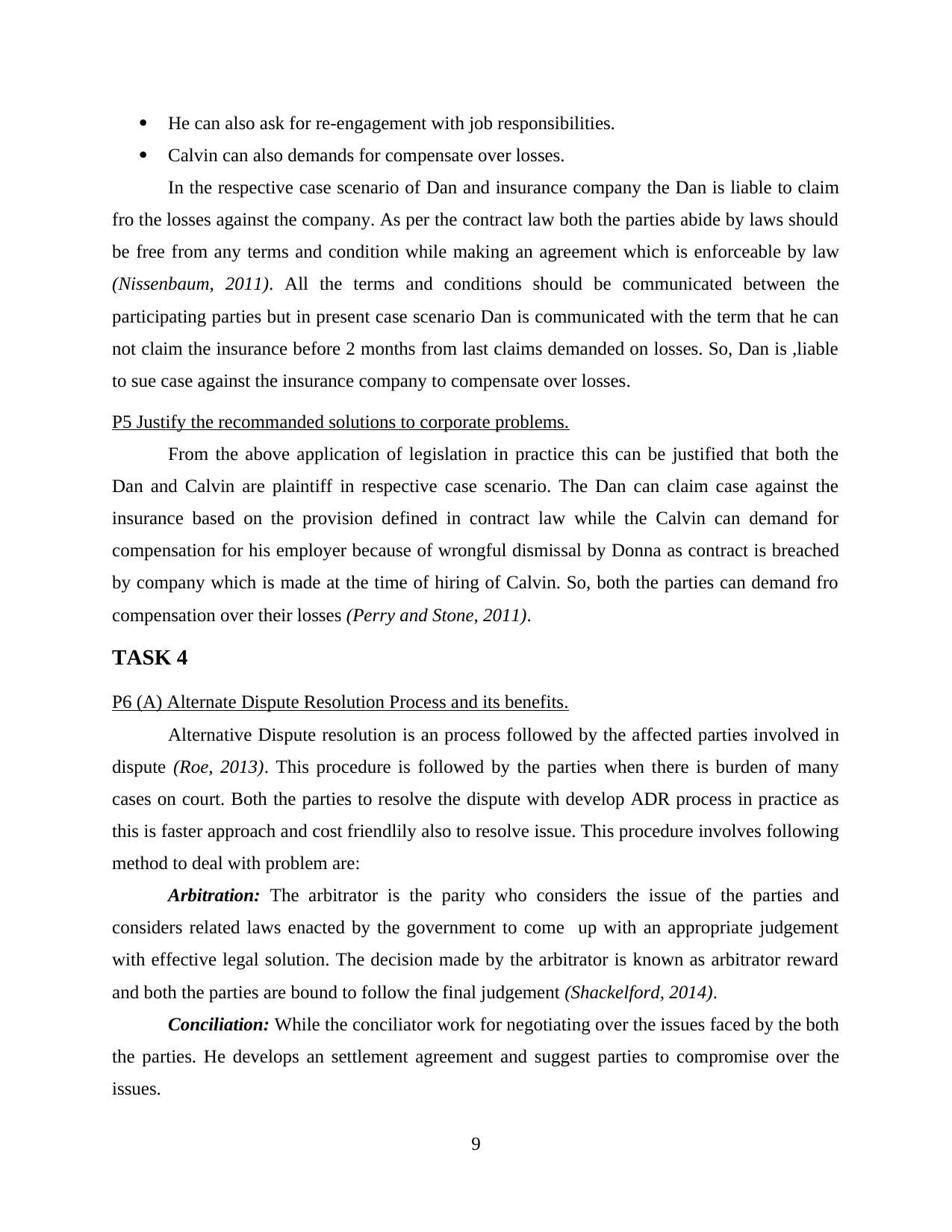
He can also ask for re-engagement with job responsibilities.
Calvin can also demands for compensate over losses.
In the respective case scenario of Dan and insurance company the Dan is liable to claim
fro the losses against the company. As per the contract law both the parties abide by laws should
be free from any terms and condition while making an agreement which is enforceable by law
(Nissenbaum, 2011). All the terms and conditions should be communicated between the
participating parties but in present case scenario Dan is communicated with the term that he can
not claim the insurance before 2 months from last claims demanded on losses. So, Dan is ,liable
to sue case against the insurance company to compensate over losses.
P5 Justify the recommanded solutions to corporate problems.
From the above application of legislation in practice this can be justified that both the
Dan and Calvin are plaintiff in respective case scenario. The Dan can claim case against the
insurance based on the provision defined in contract law while the Calvin can demand for
compensation for his employer because of wrongful dismissal by Donna as contract is breached
by company which is made at the time of hiring of Calvin. So, both the parties can demand fro
compensation over their losses (Perry and Stone, 2011).
TASK 4
P6 (A) Alternate Dispute Resolution Process and its benefits.
Alternative Dispute resolution is an process followed by the affected parties involved in
dispute (Roe, 2013). This procedure is followed by the parties when there is burden of many
cases on court. Both the parties to resolve the dispute with develop ADR process in practice as
this is faster approach and cost friendlily also to resolve issue. This procedure involves following
method to deal with problem are:
Arbitration: The arbitrator is the parity who considers the issue of the parties and
considers related laws enacted by the government to come up with an appropriate judgement
with effective legal solution. The decision made by the arbitrator is known as arbitrator reward
and both the parties are bound to follow the final judgement (Shackelford, 2014).
Conciliation: While the conciliator work for negotiating over the issues faced by the both
the parties. He develops an settlement agreement and suggest parties to compromise over the
issues.
9
Calvin can also demands for compensate over losses.
In the respective case scenario of Dan and insurance company the Dan is liable to claim
fro the losses against the company. As per the contract law both the parties abide by laws should
be free from any terms and condition while making an agreement which is enforceable by law
(Nissenbaum, 2011). All the terms and conditions should be communicated between the
participating parties but in present case scenario Dan is communicated with the term that he can
not claim the insurance before 2 months from last claims demanded on losses. So, Dan is ,liable
to sue case against the insurance company to compensate over losses.
P5 Justify the recommanded solutions to corporate problems.
From the above application of legislation in practice this can be justified that both the
Dan and Calvin are plaintiff in respective case scenario. The Dan can claim case against the
insurance based on the provision defined in contract law while the Calvin can demand for
compensation for his employer because of wrongful dismissal by Donna as contract is breached
by company which is made at the time of hiring of Calvin. So, both the parties can demand fro
compensation over their losses (Perry and Stone, 2011).
TASK 4
P6 (A) Alternate Dispute Resolution Process and its benefits.
Alternative Dispute resolution is an process followed by the affected parties involved in
dispute (Roe, 2013). This procedure is followed by the parties when there is burden of many
cases on court. Both the parties to resolve the dispute with develop ADR process in practice as
this is faster approach and cost friendlily also to resolve issue. This procedure involves following
method to deal with problem are:
Arbitration: The arbitrator is the parity who considers the issue of the parties and
considers related laws enacted by the government to come up with an appropriate judgement
with effective legal solution. The decision made by the arbitrator is known as arbitrator reward
and both the parties are bound to follow the final judgement (Shackelford, 2014).
Conciliation: While the conciliator work for negotiating over the issues faced by the both
the parties. He develops an settlement agreement and suggest parties to compromise over the
issues.
9
⊘ This is a preview!⊘
Do you want full access?
Subscribe today to unlock all pages.

Trusted by 1+ million students worldwide
1 out of 15
Related Documents
Your All-in-One AI-Powered Toolkit for Academic Success.
+13062052269
info@desklib.com
Available 24*7 on WhatsApp / Email
![[object Object]](/_next/static/media/star-bottom.7253800d.svg)
Unlock your academic potential
Copyright © 2020–2025 A2Z Services. All Rights Reserved. Developed and managed by ZUCOL.




